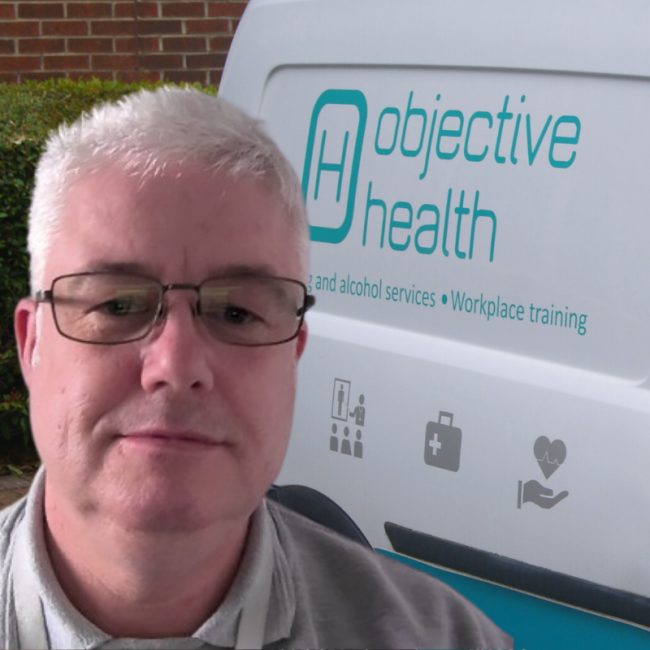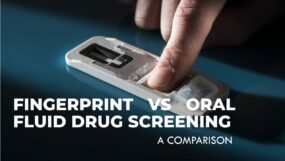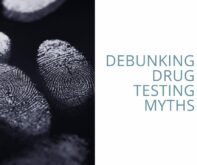With drug use on the increase, isn’t it time for businesses to adopt a much more robust drug testing approach?
04.04.2022

With drug use on the increase, isn’t it time for businesses to adopt a much more robust drug testing approach?
Intelligent Fingerprinting’s Dr Paul Yates caught up with Objective Health’s Founder, Simon Smith, to hear more about how his workplace substance testing business is putting fingerprint drug testing to use.
____
Paul Yates: What trends have you noticed in drug testing as we move beyond the pandemic?
Simon Smith: Coming out of lockdown we found that most businesses were working flat out to get their productivity up to pre-furlough levels. This inevitably meant that processes such as drug and alcohol testing were put on the back burner for a while. However, since the start of the year we’ve seen a lot of renewed interest – particularly around pre-employment screening due to recruitment growth.
Paul Yates: Have you noticed any difference in workplace drug testing results since lockdown?
Simon Smith: We’ve been surprised by a significant increase in positive cocaine tests over the last few months. Before the pandemic we typically found that around one in ten positive drug screen results were for cocaine, and these typically reflected cocaine usage over the weekend. Now though we’re seeing almost nine out of ten positive results due to cocaine, with these tests taking place throughout the week.
Paul Yates: Is that because there’s just more cocaine around these days?
Simon Smith: Despite cocaine seizures nearly tripling last year, it’s estimated that UK cocaine consumption is still at record levels. There’s a lot more of it about, with ONS data suggesting that 2.6% of the population between 16 and 59 have used cocaine during the last year. Our test results indicate that it is being used regularly by people from all walks of life, so it’s clearly a concern from a health and safety perspective.
Paul Yates: What should employers be looking out for particularly?
Simon Smith: There’s clearly a lot more recreational cocaine use. And with recruitment currently a challenge for many companies, we think there needs to be an increased focus on pre-employment tests. We recently ran some drug screening for a company with 13 new starters and nine of them tested positive for cocaine. Not surprisingly, they changed their recruitment agency!
Paul Yates: Any other areas where employers should be concerned?
Simon Smith: We’ve seen a number of cases where people have tested positive for opiates. Often that’s because people taking prescribed pain-relief medicines have returned to work and are feeling more pain. They haven’t been able to get to see a doctor to discuss their condition, so have upped their pain relief consumption to a level that they return positive test results.
Paul Yates: So, there’s a range of different reasons why you’re seeing an increase in positive test results?
Simon Smith: That’s right, and employers need to recognise that there are multiple issues that can impact people as they return to work or seek out new employment. Increased drug usage clearly also makes it even more important for businesses to manage the risks caused by drugs and alcohol across their operations. They need to have clear Health and Safety policies and robust testing for drug and alcohol abuse in place – not just to ensure employee welfare, but also to protect their colleagues as well as members of the public.
Paul Yates: So how can fingerprint-based drug testing help here?
Simon Smith: We’ve got to make it as easy as possible for employers to manage the risks caused by drugs and alcohol across their operations. Workplace drug testers will already know that urine or saliva testing can be unhygienic, time-consuming and undignified. They will also recognise that the longer window of detection offered by urine tests can be less beneficial for fitness for duty testing as drug use several days earlier – at the weekend, for example – may be detected, even though the employee is no longer under the influence at the time of testing.
Intelligent Fingerprinting’s non-invasive drug testing solution, based on fingerprint sweat analysis, brings new levels of convenience, hygiene and speed to workplace drug testing – making it an ideal solution for businesses looking to put a more robust deterrent process in place.
Using a compact, portable reader and the tamper-evident drug screening cartridge, it takes under a minute to collect the fingerprint sweat sample, with on-screen test results for cocaine, opiates, cannabis and methamphetamine provided in ten minutes. Fingerprint testing also features a shorter window of detection – within around 16 hours of the test – that provides a clearer insight into fitness for duty at the time of the test, making it ideal for workplace screening.
Paul Yates: How can Health & Safety teams make a difference here?
Simon Smith: People need to be much more open about drug and alcohol testing in the workplace. Many organisations still treat workplace drug use as something they need to hide from, and it’s often brushed underneath the carpet. The fact that you’ve got a clear workplace drug policy in place, and that you’re robust in your approach to regular drug testing across the workforce can make a huge difference. It should be seen as a positive for an organisation, reflecting the importance that a business places on health and safety, and its employees’ fitness for duty.



